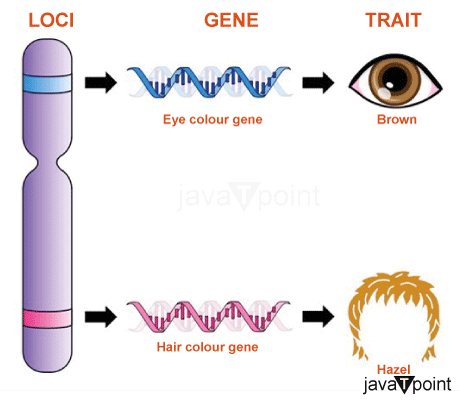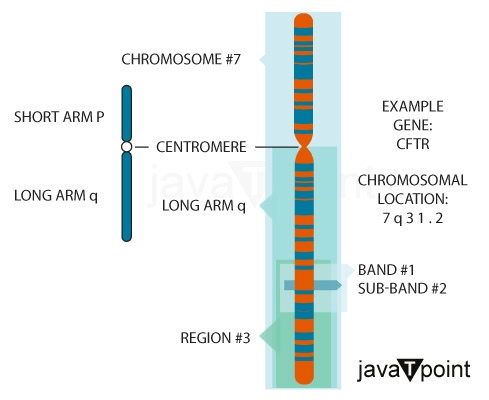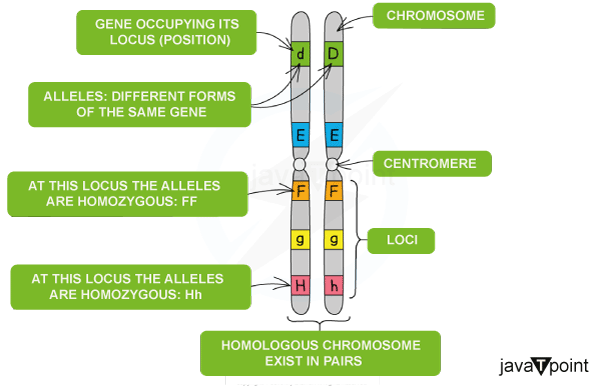Gene LocusDNA is the genetic code that establishes and codes for an organism's properties. This encompasses the organism's physiological, behavioural, and morphological characteristics. The distinct structures known as chromosomes are used for packaging and arranging DNA. A gene is a section of DNA that codes for a particular characteristic (although numerous genes may have an impact on a trait). On a chromosome, a gene has a defined location. The location of the gene on a certain chromosome is Locus(plural loci). An exact, fixed location on a chromosome where a certain gene or genetic marker is found is known as a locus (plural loci) in genetics. The overall number of protein-coding genes in a full haploid set of 23 human chromosomes is believed to be 19,000-20,000. Each chromosome contains numerous genes, with each gene occupying a separate location or locus. 
Alleles are the different variations that genes might have. An allele is also said to dwell in a specific locus. Homozygous refers to a diploid or polyploid cell's chromosomes having the same allele at a specific location. In contrast, heterozygous refers to a cell's chromosomes having variable alleles at a particular locus. A gene map is an ordered list of the loci that are known for a certain genome. The process of finding the precise locus or loci responsible for a certain phenotypic or biological characteristic is known as gene mapping. In order to map quantitative trait loci (QTLs), a technique known as association mapping-also referred to as "linkage disequilibrium mapping"-uses historical linkage disequilibrium to connect phenotypes, or observable traits, to genotypes, or an organism's genetic makeup. This method identifies genetic associations. Nomenclature of Gene LocusGeneticists employ maps to pinpoint a specific gene's position on a chromosome. In one kind of map, the position of a gene is shown by its cytogenetic location. The cytogenetic location is determined based on a characteristic pattern of bands formed when chromosomes are dyed with certain reagents. The molecular location, an accurate description of a gene's location on a chromosome, is used in another kind of map. The molecular location is determined by the configuration of the DNA building units (nucleotides) that make up a chromosome. Cytogenetic LocationThe cytogenetic location of a gene is described by geneticists in a standardized manner. Most of the time, the location refers to a specific band's location on a stained chromosome: 17q12 If less information is available regarding the precise location, it may alternatively be expressed as a range of bands: 17q12-q21 
The "address" of a gene on a chromosome is made up of a mixture of numbers and letters. There are numerous components to this address:
Molecular LocationThe nucleotide order for each human chromosome was discovered by the Human Genome Project, an international scientific project that was finished in 2003. Because of sequencing information, researchers can now give many genes a more precise address than their cytogenetic location. The molecular address of a gene identifies the precise nucleotide position of that gene. It specifies the specific location of the gene on a chromosome and its size. Researchers can exactly determine how near or how distant a gene is from other genes on the same chromosome by understanding the molecular location. Several research teams frequently give the molecular position of a gene slightly varied values. A gene's molecular address may differ slightly depending on the method used by researchers to analyse the human genome sequence. Points to Ponder about Gene Loci
Next TopicGene Regulation in Eukaryotes
|
 For Videos Join Our Youtube Channel: Join Now
For Videos Join Our Youtube Channel: Join Now
Feedback
- Send your Feedback to [email protected]
Help Others, Please Share









